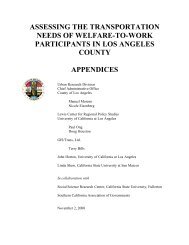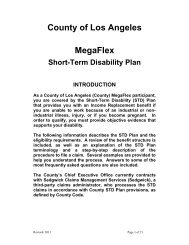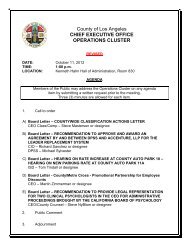Prevention and Early Intervention (PEI) Plan - Chief Executive Office ...
Prevention and Early Intervention (PEI) Plan - Chief Executive Office ...
Prevention and Early Intervention (PEI) Plan - Chief Executive Office ...
You also want an ePaper? Increase the reach of your titles
YUMPU automatically turns print PDFs into web optimized ePapers that Google loves.
The Los Angeles County Department of<br />
Mental Health (DMH) is undertaking an<br />
intensive, inclusive, <strong>and</strong> multi-faceted<br />
approach to developing the County’s<br />
<strong>Prevention</strong> <strong>and</strong> <strong>Early</strong> <strong>Intervention</strong> (<strong>PEI</strong>)<br />
<strong>Plan</strong>, one of five plans authorized by the<br />
Mental Health Services Act (MHSA)<br />
enacted by California voters in 2004.<br />
<strong>Prevention</strong> in mental health involves<br />
reducing risk factors or stressors, building<br />
protective factors <strong>and</strong> skills, <strong>and</strong><br />
increasing support. <strong>Prevention</strong> promotes<br />
positive cognitive, social <strong>and</strong> emotional<br />
development <strong>and</strong> encourages a state of<br />
well-being that allows the individual to<br />
function well in the face of changing <strong>and</strong><br />
sometimes challenging circumstances.<br />
<strong>Early</strong> <strong>Intervention</strong> is directed toward<br />
individuals <strong>and</strong> families for whom a short<br />
duration (usually less than one year) <strong>and</strong><br />
relatively low-intensity intervention is<br />
appropriate to measurably improve a<br />
mental health problem or concern very<br />
early in its manifestation, thereby<br />
avoiding the need for more extensive<br />
mental health treatment or services; or<br />
preventing a mental health problem from<br />
getting worse.<br />
Service Area Approach. The focus for<br />
developing the L.A. County <strong>PEI</strong> <strong>Plan</strong> is at<br />
the Service Area level—utilizing<br />
informational meetings, key informant<br />
interviews, focus groups, <strong>and</strong> community<br />
forums. Service Area profiles identifying<br />
socio-economic demographic data <strong>and</strong><br />
mental health statistics, as well as data<br />
related to health, education, social<br />
services, <strong>and</strong> public safety will be<br />
developed to aid the planning process.<br />
The State Department of Mental Health (SDMH)<br />
has targeted 5 community mental health needs,<br />
6 priority populations, <strong>and</strong> 6 statewide efforts<br />
for the <strong>Prevention</strong> <strong>and</strong> <strong>Early</strong> <strong>Intervention</strong><br />
program:<br />
Key Community Mental Health Needs<br />
• Disparities in Access to Mental Health<br />
Services<br />
• Psycho-Social Impact of Trauma<br />
• At-Risk Children, Youth <strong>and</strong> Young Adult<br />
Populations<br />
• Stigma <strong>and</strong> Discrimination<br />
• Suicide Risk<br />
Priority Populations<br />
• Underserved Cultural Populations<br />
• Individuals Experiencing Onset of Serious<br />
Psychiatric Illness<br />
• Children/Youth in Stressed Families<br />
• Trauma-Exposed<br />
• Children/Youth at Risk for School Failure<br />
• Children/Youth at Risk of or Experiencing<br />
Juvenile Justice Involvement<br />
State-Administered Projects<br />
• Suicide <strong>Prevention</strong><br />
• Stigma <strong>and</strong> Discrimination Reduction<br />
• Ethnically <strong>and</strong> Culturally Specific Programs<br />
<strong>and</strong> <strong>Intervention</strong>s<br />
• Training, Technical Assistance <strong>and</strong> Capacity<br />
Building<br />
• Student Mental Health Initiative<br />
• Statewide Evaluation<br />
<strong>Prevention</strong><br />
CSS<br />
Treatment & Recovery<br />
Sector Partnerships. SDMH has identified 7<br />
sectors that counties must partner with to<br />
develop their <strong>PEI</strong> <strong>Plan</strong>. Community partnerships<br />
<strong>and</strong> resource leveraging are required with:<br />
► Underserved Communities<br />
► Education<br />
► Individuals with Serious Mental Illness<br />
<strong>and</strong>/or Their Families<br />
► Providers of Mental Health Services<br />
► Health<br />
► Social Services<br />
► Law Enforcement<br />
SDMH also recommended additional sectors,<br />
including community family resource centers,<br />
employment, <strong>and</strong> media.<br />
Funding. The following chart lists the<br />
estimated funding amounts for Los Angeles<br />
County from 2007-2009.<br />
FISCAL YEAR<br />
2007‐2008<br />
LA COUNTY DMH<br />
<strong>PEI</strong> ESTIMATED FUNDING<br />
$34,001,800 *<br />
2008‐2009 $57,161,000<br />
*includes $7,074,500 million in planning funds<br />
TOTAL: $91,162,800<br />
A minimum of 51% of the overall County <strong>PEI</strong> <strong>Plan</strong><br />
budget must be dedicated to the child (ages 0-<br />
15) <strong>and</strong> transition-age youth (TAY ages 16-25)<br />
populations.<br />
_____ Please send me information on future <strong>PEI</strong> meetings. ____ I would be willing to participate in a focus group for <strong>PEI</strong> planning.<br />
Name:<br />
Organization:<br />
Position/Title:<br />
Address:<br />
City, State, Zip Code:<br />
Email:<br />
Phone:<br />
Please check the category or sector that is most applicable to you:<br />
_____ Mental Health Consumer _____ Health _____ Education<br />
_____ Family Member/Parent of Mental Health Consumer _____ Social Services _____ Law Enforcement<br />
_____ Mental Health Provider _____ Employment _____ Media<br />
_____ Faith-Based Organization _____ Community Member _____ Other Government Agency<br />
_____ Other
















